17 December 2002: Antofagasta, Chile
Subject: Bolivia
We've just arrived in Antofagasta, on the Chilean coast. This is the first time we've been at sea level for weeks and weeks - there is a lot more atmosphere here and it is hot too.
The Salar de Uyuni
We spent three days in a Toyota Landcruiser getting from Uyuni in Bolivia's Altiplano to San Pedro de Atacama in Chile. The trip passes through some extraordinary landscapes and was well worth doing, though it is a shame that the company we went with were so dodgy.
This part of the Andees is very dry and much of the land drains into inland evaporation basins rather than the oceans. For example, the outflow from Lake Titicaca flows into Lago Poopo from where it evaporates. Some of these lakes have water in all year - albeit very salty water. Others are dry salt lakes during the dry season that get a bit soggy when the rains come. The Salar de Uyuni, which we crossed on the first day, is in the latter category. It is an enormous expanse of white salt for as far as the eye can see (and quite a bit further). The locals dig it up and sell it, and have probably been doing so for hundreds of years. The heat makes odd things happen at the horizon, and from a distance it looks as if their piles of sand are hovering in mid air!

In the middle of the salt is the Isla Del Pescado, so named because its profile from a distance looks a bit like a fish (hmmm). This was our lunch stop and it is a fascinating place because it is covered in the most enormous cactuses, the tallest about 12m tall and said to be 1200 years old.
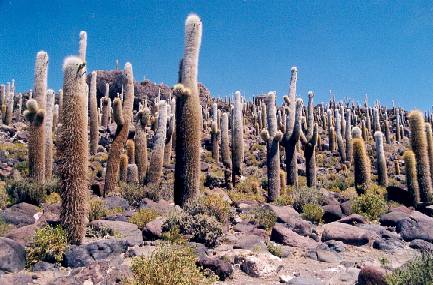
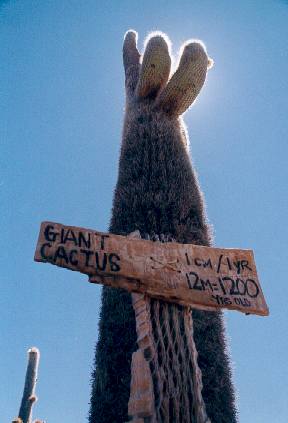
Lagunas
It took a few more hours driving over the smooth salt to leave the Salar, and the subsequent tracks were much rougher. We spent the night in a tiny place called San Juan which seems to exist mainly because it has a water hole where their llamas can drink.
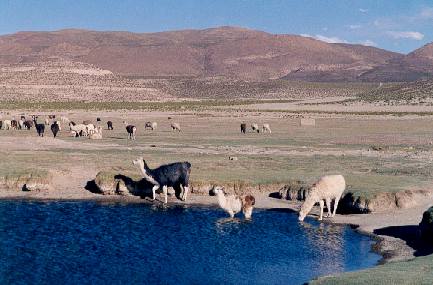
Then on the second day we started off with a rough drive through the desert, our discomfort briefly eased by a stop where we saw these very odd plants that look like they should be soft as moss but are actually rock hard.
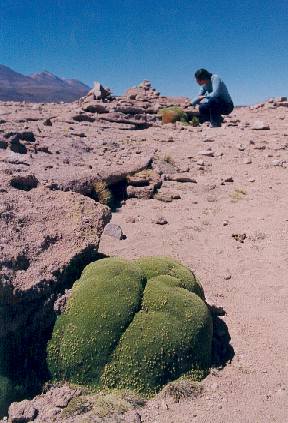
Then we visited a sucession of salt water lagoons full of flamingoes. Apparently there are three different sorts of flamingoes but they aren't easy to tell apart. Apart from the birds the other wildlife to see are the vicuñas, the wild camelids from which the early humans bred llamas. Vicuñas are much less stocky than llamas which are clearly much more suitable as beasts of burden.
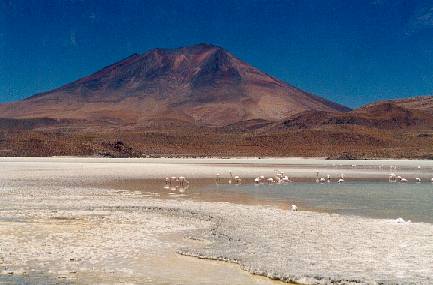
Finally we crossed some more high-vibration desert, including a stop to see this "stone tree", carved by the wind. (And you can believe that as it was quite windy when we were there!)
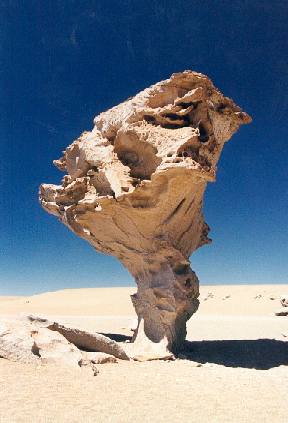
Many of the lagunas are brightly coloured - red, green or yellow, depending on how much salt is in them and what colourful bacteria can put up with the conditions. This is Laguna Colorado.
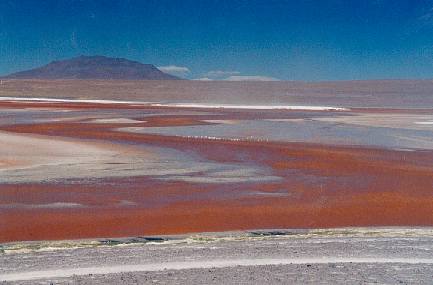
We spent the final night in the middle of nowhere before making an early start to see the geothermal attractions of the final day.
Boiling Mud!
Apparently this looks best early in the morning, so we set off at five AM! There are a few steam vents (which they call geysirs, but aren't) and some boiling mud pots, very much like the ones I saw in Iceland. Then we had breakfast at a hot spring before driving almost the last leg to Laguna Verde. This salt water lake is green for some reason and reflects Volcan Licancabur, a 5900m peak on the Chilean border.
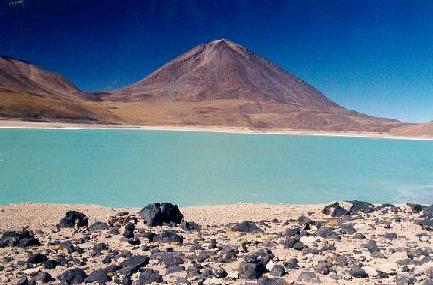
Generally we stopped only for a few minutes at each of these points of interest. We spent much more time looking out of the windows of our Landcruiser at the passing desert. It would have been very interesting to know something about the geology, but we had only a driver, not a guide. I think that the desert is mostly volcanic material, probably from erruptions eons ago. It could be the sort of place where you can find meteorites! Quite a few of the hills had bright yellow sulphurous patches on them, but only one showed any signs of current activity: a spurt of steam from the side.
Into Chile
The Bolivians actually have a frontier post where you get your passport stamped. The Chileans are happy for you to wait until you get a couple of thousand meters lower down before they process you. The frontier pass is at 4480m, making it higher than the high point of the Cusco-Puno railway and so the highest point on the trip so far.
On the Bolivian side the nearly-6000m peaks rise from a 4000m plain. On the Chilean side they rise from a 2500m plain, making them much more impressive! We drove down from the pass to the town of San Pedro de Atacama following old lava flows from Volcan Licancabur, which sticks up with a classic volcano shape. Finally we got to the border control. As well as conveying tourists like us the road also leads to a pass into Argentina, and we had seen trucks taking new cars to Paraguay. The frontier was not a good introduction to the country. They made us wait for three quarters of and hour, and then did a thorough job of looking through everyones' rucksacks. They made me unseal and open up my first aid kit which has been carefully packed up for years. But if anyone really wanted to smuggle in some coca leaves, or fresh fruit and veg, or whatever it is they're looking for, they need only put it at the bottom of their bag.
Dodgy Tourismo Desierto
Our guidebook has a comment like "generally tour operators in Uyuni are terrible" and gives an address to complain to before going on to mention some less-bad companies. But this book has proved incredibly unreliable recently and we got the firm impression that things had improved recently. This turned out not to be the case.
Since their customers leave the country at the end of the trip the tour operators know that there is little chance that they will be able to complain effectively. So they promise all sorts of things when you sign up and then fail to deliver them.
In our case, I have a document signed by Tourismo Desierto where they say that the price we paid includes entrance to the two national parks, free drinking water, and various other things. But when we actually got to the Isla Del Sol our driver (Octavia) refused to pay up and we had to pay again ourselves. The same thing happened at the national park office for the Lagunas, and we had to buy our own drinking water (a rare commodity in the middle of a desert). As well as the money that we lost it really made the trip feel unpleasant: we had to sit for hours in a vehicle with a man who had robbed us and who we knew was going to get away with it. (The is a small police presence in the area but they all seem to be old friends of his, so going to them didn't seen like a promising idea.)
Anyway I will be writing to the complains address that our guidebook gives. I'm also hoping that maybe this mention of Tourismo Desierto of Uyuni (and their partners-in-crime Pamela Tours with whom the vehicle was shared) will alert others to these particular crooks.